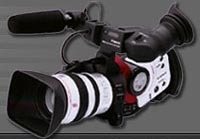
Digital Video Camera Buying Guide
Written by Holly Madden | Posted by: Anonymous
Beta SP is still the industry standard, but digital video is hot on its heels. So what’s the big draw? For many local videographers, it comes down to great picture quality and lightweight cameras at a much more affordable price.
This was the case for Abby Freedman, founder of Red Head Productions. Previously, Freedman had to rent Beta SP equipment to produce broadcast-quality documentaries and educational and training videos. But when the Sony VX1000 came on the market, priced in the $3,000 range, she found she could actually afford to own her own digital video camera.
"The VX1000 is very lightweight as opposed to a Beta SP camera; it’s also smaller, less obtrusive," Freedman says. "This is really important when I’m conducting interviews for my documentaries, because it creates a greater intimacy between me and my subject."
Another advantage, according to Freedman, is that the camera is far more comfortable, easier to maneuver, than the heavier, more cumbersome Beta SP equipment. Freedman is currently using the VX1000 to shoot "G-Clefs," her upcoming documentary about a 1950s hit doo wop band still performing today.
For Ben Achtenberg, documentarian and head of Fanlight Productions, the camera of choice is the Panasonic AJD-200, priced in the $8,000 range. "I chose this model because it’s the least expensive semi-pro camera I found on the market," he says. "It also has a removable lens, and it looks like a broadcast camera, which is really important when you’re on a shoot and you want to project a professional image."
The camera does, however, have one minor drawback. "The particular model I own has no manual audio control," Achtenberg explains. "It adjusts its sound recording level automatically. However, the new D200 models do have this feature."
Overall, Achtenberg sees the digital format as far superior to super VHS, and on a par with Beta SP quality. "Plus," he adds, "the affordable price makes it easy to own your own equipment, as opposed to renting. This is a huge advantage, especially if you’re working on a low-budget project."
To add to the savings, DV tapes costs about $10 each and run up to 184 minutes, as opposed to Beta SP tapes, which cost about $20 each and run only up to 20 minutes.
Fred Simon, a videographer at the Center of Independent Documentary, is also a big proponent of the new digital cameras. When the Sony DSR-300, a DV cam priced in the $10,000 range, went on the market early this summer, Simon received one of the first shipped to Boston.
"I bought it for three reasons," Simon says. "First, it offers me image quality equal to, if not better than, an analog Betacam. Second, it’s much lighter than Betacam-about eight pounds less. Third, in the long run, digital tape is superior to analog, because there’s less generational loss."
Simon also chose the DSR-300 because it offers 750 lines of resolution and uses a half-inch chip. "The larger the chip, the more pixels, the sharper the image," he explains. In addition, he lauds the quality of the audio input and the burn-in time code feature.
Brooks Wynn, media consultant for Crimson Tech and freelance videographer, offers a wealth of insight into the pros and cons of these cameras. "When the Sony VX1000 came out three years ago, it was like the invention of penicillin in the medical industry," he says. "The quality is still fantastic, and at just $3,000, it s a wonderful pro-sumer camera for event videographers and promotional and corporate training videos." ["Pro-sumer" is an industry term which means one grade above consumer quality and one level below professional quality.]
Wynn does note one downside of the camera. "I describe it as a high- performance engine running on cheap gas," he explains. "The lens in the camera is no different than a consumer piece of glass."
As for the Canon XL1, a mini-DV camera priced at $4,500, Wynn praises its elite lensing design: "It has a strong engine, an interchangeable lens, high-resolution glass, superior image quality, and depth of field." Another advantage he points out is an attachable shoulder harness that features two XLR inputs for microphones.
In addition, the camera has what Wynn called great "natural balance." "It reacts beautifully to shoulder shooting and steadicam riding," he says. "It makes it easy to hook up secondary accessories. And there’s no wrist attachment like the Sony VX1000, which is very unstable."
As for the downside of the camera, the Canon has no manual audio override. It also has a very sensitive, panicky LED; it’s not always accurate about how hot the sound recording is. The loading mechanism is a bit quirky as well. The operator must load the tape, then depress the door twice in order for the camera to record.
Moving up the price range, Wynn applauds the Sony DSR-300 for its fugieonon lens, comparing it to a precision-cut diamond. "This camera is definitely not pro-sumer. It’s a professional-quality camera with high-resolution glass. On price and performance, it gives Beta SP a run for the money."
Wynn says Crimson Tech sells over 30 different digital video cameras, with prices running as high as $30,000. The higher the camera’s price, the better the lens quality, the more lines of resolution, the larger the chip size, and the better the circuitry. Although most professional broadcasters continue to use Beta SP, the affordable quality of digital video is reshaping the industry. And, according to Wynn, the prices of Beta SP have slowly decreased since the introduction of digital video.
See a list of places that sell or rent digital cameras in the NewEnglandFilm.com Industry Directory.









